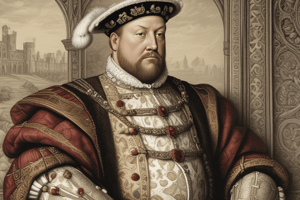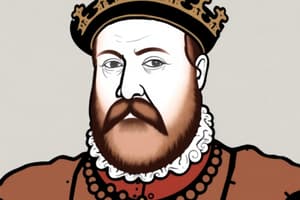Podcast
Questions and Answers
Which wife of Henry VIII was beheaded on 13 February 1542?
Which wife of Henry VIII was beheaded on 13 February 1542?
- Anne Boleyn
- Catherine Parr
- Catherine Howard (correct)
- Jane Seymour
Which monarch earned the nickname 'Bloody Mary' due to her persecution of Protestants?
Which monarch earned the nickname 'Bloody Mary' due to her persecution of Protestants?
- Mary I (correct)
- Catherine Parr
- Jane Seymour
- Elizabeth I
Who succeeded Henry VIII on the English throne?
Who succeeded Henry VIII on the English throne?
- Elizabeth I
- Jane Seymour
- Mary I
- Edward VI (correct)
Which monarch restored the Church of England to its pre-Reformation form?
Which monarch restored the Church of England to its pre-Reformation form?
Who was the first monarch of the Tudor dynasty?
Who was the first monarch of the Tudor dynasty?
Why did King Henry VIII establish the Church of England in 1534?
Why did King Henry VIII establish the Church of England in 1534?
What happened to Anne Boleyn in 1536?
What happened to Anne Boleyn in 1536?
Which event led to the English Reformation?
Which event led to the English Reformation?
What act formalized King Henry VIII as the Supreme Head of the Church of England?
What act formalized King Henry VIII as the Supreme Head of the Church of England?
What symbolizes the unity of the two warring households during the Wars of the Roses?
What symbolizes the unity of the two warring households during the Wars of the Roses?
How did Henry VII secure his rule after ascending the throne in 1485?
How did Henry VII secure his rule after ascending the throne in 1485?
Who was Henry VII's predecessor, whose reign ended the Wars of the Roses?
Who was Henry VII's predecessor, whose reign ended the Wars of the Roses?
What significant battle led to Henry VII's ascension to the throne in 1485?
What significant battle led to Henry VII's ascension to the throne in 1485?
Which event is NOT associated with Henry VII's efforts to secure his rule?
Which event is NOT associated with Henry VII's efforts to secure his rule?
What event marked the end of the Wars of the Roses?
What event marked the end of the Wars of the Roses?
Who succeeded Henry VII on the English throne?
Who succeeded Henry VII on the English throne?
Which Tudor monarch is known for their significant role in the English Reformation?
Which Tudor monarch is known for their significant role in the English Reformation?
Who was one of the 'Princes in the Tower' who was claimed to be leading a rebellion against Henry VII?
Who was one of the 'Princes in the Tower' who was claimed to be leading a rebellion against Henry VII?
Which Tudor monarch is known for their significant role in the religious reformation of England?
Which Tudor monarch is known for their significant role in the religious reformation of England?
Flashcards
Wars of the Roses
Wars of the Roses
A series of dynastic conflicts between the English monarchy and nobility from 1455 to 1487.
Elizabeth of York
Elizabeth of York
King Henry VII's wife, who united the House of York and Lancaster during the Wars of the Roses.
King Henry VIII
King Henry VIII
The second son of Henry VII, who succeeded his father in 1509 after his older brother's death.
Tudor Dynasty
Tudor Dynasty
Signup and view all the flashcards
War of the Roses
War of the Roses
Signup and view all the flashcards
Battle of Bosworth Field
Battle of Bosworth Field
Signup and view all the flashcards
Henry Tudor
Henry Tudor
Signup and view all the flashcards
English Reformation
English Reformation
Signup and view all the flashcards
Church of England
Church of England
Signup and view all the flashcards
Annulment of Marriage
Annulment of Marriage
Signup and view all the flashcards
Catherine of Aragon
Catherine of Aragon
Signup and view all the flashcards
Anne Boleyn
Anne Boleyn
Signup and view all the flashcards
Act of Supremacy
Act of Supremacy
Signup and view all the flashcards
Dissolution of Monasteries
Dissolution of Monasteries
Signup and view all the flashcards
Jane Seymour
Jane Seymour
Signup and view all the flashcards
Catherine Howard
Catherine Howard
Signup and view all the flashcards
Catherine Parr
Catherine Parr
Signup and view all the flashcards
Edward VI
Edward VI
Signup and view all the flashcards
Mary I
Mary I
Signup and view all the flashcards
Elizabeth I
Elizabeth I
Signup and view all the flashcards
Study Notes
King Henry VIII (1491-1547) was the second son of King Henry VII and Elizabeth of York, who united the Wars of the Roses, a series of dynastic conflicts between the English monarchy and nobility that lasted from 1455 to 1487. Born on 28 June 1491, Henry was not initially intended to become king, but his older brother, Arthur, died young, and he succeeded his father in 1509.
The Tudor dynasty began during the War of the Roses, a conflict between the House of York and the House of Lancaster that ended when Henry Tudor, a Lancastrian, defeated Richard III of the House of York at the Battle of Bosworth Field in 1485. Henry united the rival houses by marrying Elizabeth of York, a Yorkist, and their descendants ruled England until 1603 with the death of Elizabeth I.
King Henry VIII was a key figure in the English Reformation, which sought to reform the Roman Catholic Church. In 1534, he established the Church of England, with himself as its head, known as the Anglican Church. This break with the papacy was influenced by the desire to annul his marriage to Catherine of Aragon, who had failed to produce a male heir.
Henry was famously known for his six marriages, which included Anne Boleyn, who was queen from 1533 to 1536. Their marriage was annulled after Anne was accused of adultery and treason, leading to her execution on 19 May 1536. Other wives of Henry VIII included Anne Boleyn's sister, Jane Seymour, who died after giving birth to Edward VI, Catherine Parr, and Catherine Howard, who was beheaded on 13 February 1542.
During Henry's reign, the Act of Supremacy was passed in 1534, asserting the monarch's supreme headship of the Church of England. This allowed him to dissolve monasteries and seize their wealth, which contributed to the economic growth of the kingdom.
After Henry's death, his son Edward VI ruled for six years before dying at the age of 15. He was succeeded by his sister, Mary I, also known as Bloody Mary due to her persecution of Protestants. Mary's reign was brief, and she was succeeded by her half-sister, Elizabeth I, who reigned from 1558 to 1603. Elizabeth is often considered one of England's greatest monarchs, known for her strong leadership and the eventual restoration of the Church of England to its pre-Reformation form.
In conclusion, King Henry VIII was a pivotal figure in the Tudor dynasty and the English Reformation. His reign saw the establishment of the Church of England and the dissolution of monasteries, as well as the marriage to and execution of Anne Boleyn. Henry's six marriages and the subsequent reigns of his children, Edward VI, Mary I, and Elizabeth I, shaped the course of English history.
Studying That Suits You
Use AI to generate personalized quizzes and flashcards to suit your learning preferences.




